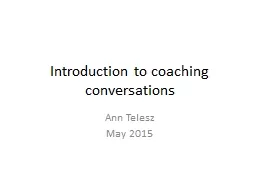

Ann Telesz May 2015 Aims To introduce coaching conversations as part of communication skills To introduce the idea of Health Coaching To practice conversations using coaching and advising ID: 547054
Download Presentation The PPT/PDF document "Introduction to coaching conversations" is the property of its rightful owner. Permission is granted to download and print the materials on this web site for personal, non-commercial use only, and to display it on your personal computer provided you do not modify the materials and that you retain all copyright notices contained in the materials. By downloading content from our website, you accept the terms of this agreement.
Slide1
Introduction to coaching conversations
Ann Telesz
May 2015Slide2
Aims
To
introduce coaching conversations as part of communication
skills
To introduce the idea of Health Coaching
To practice
conversations using
coaching and
advising Slide3
Objectives
to differentiate between coaching and other types of
conversation
to identify scenarios when a coaching approach could be usefulSlide4
What is coaching?
‘The coach works with clients to achieve speedy, increased and sustainable effectiveness in their lives and careers through focused learning. The coach’s sole aim is to work with the client to achieve all of the client’s potential – as defined by the client’
Jenny Rogers Coaching Skills A Handbook 2008Slide5
Principles of coaching
The client is resourceful
The coach’s role is to develop the client’s resourcefulness through skilful questioning, challenge and support
Coaching addresses the whole person – past, present and future
The client sets the agenda
The coach and client are equals
Coaching is about change and actionSlide6
What is coaching not?
Advice
Performance review
Patronage by senior in the field
Counselling
PsychotherapySlide7
‘The
success of coaching and mentoring is in the
establishment of an effective relationship based upon
mutual respect, honesty and understanding, combined
with structured questioning to enable the
coachmentee
to find their own solutions
.’Slide8
Exercise in pairs
Think of something that you have been wanting to do something about, but haven’t managed e.g. a New Years resolution.
Now tell your colleague about that. And get your colleague to give you their best advice for no longer than a minute, then swap round for a further minuteSlide9
Questions only
Now repeat the process concentrating on active listening and when you speak using questions only for 5mins
Do this just one way in your pair
What questions work?Slide10
In relation to the topic you were talking about
What do you specifically want to change?
How will you know that you have succeeded?
What benefits will success bring?
How are you stopping yourself making this change?
When have you had success in the past, at least in part?
What can you learn from that success?
What is the first step nowSlide11
Models of Coaching
IGROW
Egan’s skilled helper
Coaching with the Kipper TieSlide12
Kipper
K Key issues and goals
I Importance and Implications
P Present Situation
P Perfect World and Possibilities
E Evaluating Choices
R Resolutions and Review
Management Futures Consulting Limited 2013Slide13
Trainee exercise
Work in group of 3 where one is an observer
Think of an issue you have had with a trainee
Briefly describe it to a colleague
Role play the trainee with a trainer adopting a coaching approach
Observer to monitor Slide14
Health coaching is…
‘
a method
of patient education that guides and prompts a patient to be an active participant in behaviour
change
’Slide15
Traditional
Approach
Health Coaching Approach
Decisions are made by the clinician
Decisions are made in patient-clinician partnership
Patient told what to do
Patient finds their own solutions
Patient believes it is the clinician's role to fix them
Patient believes that they have an active role to play in changing to improve their own health
Goals are set by the clinician and success is measured by them
The patient is supported to define their own goals & success is measured by their attainment
Patient required to change as requested
Collaboration and assistance in facilitating change
Psychological barriers to change not considered
Psychological barriers to change included
Focus on extrinsic motivators
Intrinsic motivators includedSlide16
Health coaching exercise
Think of a patient with a long term health condition where you feel you have not been getting the message across
In groups of 3 – patient, doctor and observer try a coaching approachSlide17
Objectives
to differentiate between coaching and other types of
conversation
to identify scenarios when a coaching approach could be usefulSlide18
Questions?Slide19
Balance Wheel Exercise
© Management FuturesSlide20
Resources
Coaching courses including Coaching for Health
www.mentoring.londondeanery.ac.uk/training
Applying for coaching www.mentoring.londondeanery.ac.uk
Coaching
and Mentoring Team
t:
020 7866 3242
e:
mentoring@nwl.hee.nhs.uk